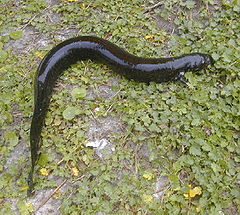Syrenowate
| Sirenidae[1] | |||||
| J.E. Gray, 1825[2] | |||||
 Przedstawiciel rodziny – syrena jaszczurowata (S. lacertina) | |||||
| Systematyka | |||||
| Domena | |||||
|---|---|---|---|---|---|
| Królestwo | |||||
| Typ | |||||
| Podtyp | |||||
| Gromada | |||||
| Rząd | |||||
| Podrząd | |||||
| Rodzina |
syrenowate | ||||
| Typ nomenklatoryczny | |||||
|
Siren Linnaeus, 1767 | |||||
| |||||
| Rodzaje | |||||
| |||||
Syrenowate (Sirenidae) − rodzina płazów z rzędu płazów ogoniastych (Caudata).
Zasięg występowania[edytuj | edytuj kod]
Rodzina obejmuje gatunki występujące na południowo-wschodnich terenach USA i w skrajnie północno-wschodnim Meksyku[15].
Charakterystyka[edytuj | edytuj kod]
Przedstawiciele tej rodziny żyją w wodach stojących, odżywiają się drobną zwierzyną i roślinnością. Posiadają zarówno płuca, jak i skrzela. Prawdopodobnie neoteniczne.
Systematyka[edytuj | edytuj kod]
Do rodziny należą następujące rodzaje[15]:
- Pseudobranchus Gray, 1825
- Siren Österdam, 1766
Przypisy[edytuj | edytuj kod]
- ↑ Sirenidae, [w:] Integrated Taxonomic Information System (ang.).
- ↑ a b J.E. Gray. A synopsis of the genera of reptiles and Amphibia, with a description of some new species. „Annals of Philosophy”. New Series. 10, s. 215, 1825. (ang.).
- ↑ P.A. Latreille: Familles Naturelles du Règne Animal, Exposées Succinctement et dans un Ordre Analytique, avec l’Indication de leurs Genres. Paris: J. B. Baillière, 1825, s. 105. (fr.).
- ↑ F. von Ritgen. Versuch einer natürlichen Eintheilung der Vögel. „Nova Acta Physico-medica Academiae Caesareae Leopoldino-Carolinae Naturae Curiosorum”. 14, s. 277, 1828. (niem.).
- ↑ W.F. Hemprich: Grundiss der Naturgeschichte für höhere Lehrenstatlen. Wyd. 2 (Zweite Ausflage). Berlin: August Rüder, 1829, s. xix. (niem.).
- ↑ C.E. von Eichwald: Zoologia Specialis, quam Expositis Animalis tum Vivis, tum Fossilibus potossimum Rossiae in Universum, et Poloniae in Species, in Usum Lectionum Publicarum in Universitate Caesarea Vilnensi habendarum edidit. T. 3. Vilnius: Josophi Zawadski, 1831, s. 163. (łac.).
- ↑ H.M.D. de Blainville. Description de quelques espèces de reptiles de la Californie, précédée de l’analyse d’un système général d’erpétologie et d’amphibiologie. „Nouvelles Annales du Muséum d’Histoire Naturelle”. 4, s. 280, 1835. Paris. (fr.).
- ↑ J. Hogg. On the classification of the Amphibia. „Annals of Natural History”. 1, s. 152, 1838. (ang.).
- ↑ Ch.L. Bonaparte. Systema Amphibiorum. „Mémoires de la Société des sciences naturelles de Neuchâtel”. 2, s. 16, 1839. (łac.).
- ↑ L.J.F.J. Fitzinger: Systema reptilium. Fasciculus primus, Amblyglossae. Wien: Braumüller et Seidel, 1843, s. 35. (łac.).
- ↑ H.F. Stannius: Die Amphibien. W: C.T.E. von Siebold & H.F. Stannius (red.): Handbuch der Zootomie der Wirbelthiere. Wyd. 2. Cz. 2. Berlin: Von Viet & Co., 1856, s. 4. (niem.).
- ↑ F.K. Knauer: Naturgeschichte der Lurche. (Amphibiologie.) Eine umfassendere Darlegung unserer Kenntnisse von dem anatomischen Bau, der Entwicklung und systematischen Eintheilung der Amphibien sowie eine eingehende Schilderung des Lebens dieser Thiere. Wien: A. Pichler’s witwe & Sohn, s. 95. (niem.).
- ↑ O.P. Hay: Second bibliography and catalogue of the fossil Vertebrata of North America, Publication 390 of the Carnegie Institute of Washington. Cz. 1. Washington D. C.: Carnegie Institution of Washington, 1930, s. 848. (ang.).
- ↑ a b A. Dubois. Amphibia Mundi. 1.1. An ergotaxonomy of Recent amphibians. „Alytes”. 23 (1), s. 20, 2005. (ang.).
- ↑ a b D. Frost: Sirenidae Gray, 1825. [w:] Amphibian Species of the World 6.1, an Online Reference [on-line]. American Museum of Natural History. [dostęp 2022-12-23]. (ang.).

